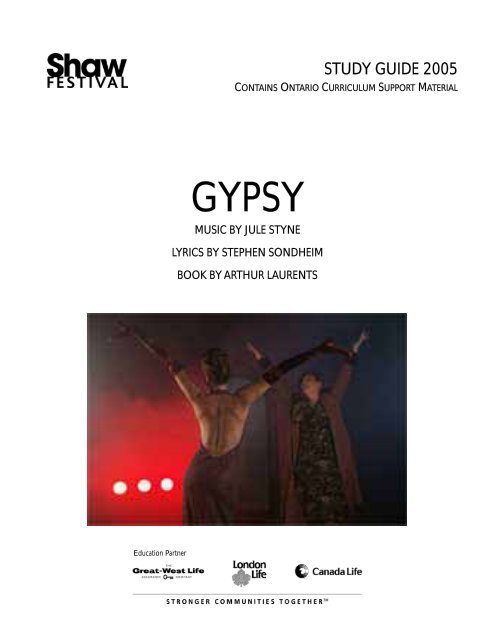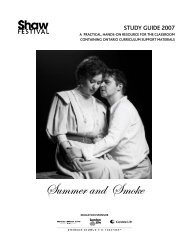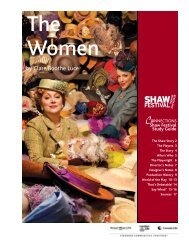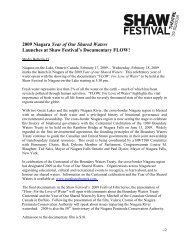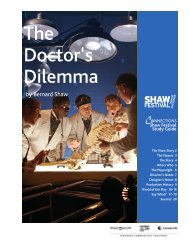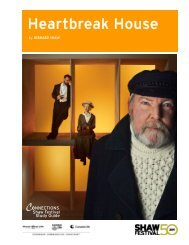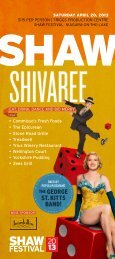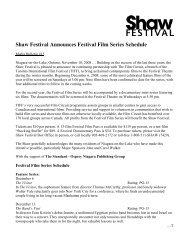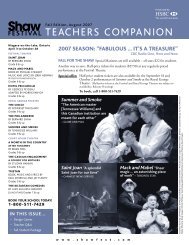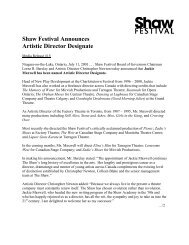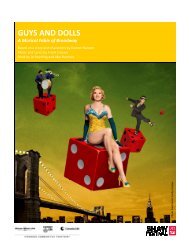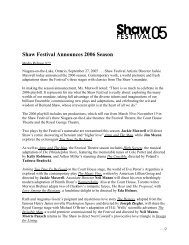STUDY GUIDE 2005 - Shaw Festival Theatre
STUDY GUIDE 2005 - Shaw Festival Theatre
STUDY GUIDE 2005 - Shaw Festival Theatre
You also want an ePaper? Increase the reach of your titles
YUMPU automatically turns print PDFs into web optimized ePapers that Google loves.
<strong>STUDY</strong> <strong>GUIDE</strong> <strong>2005</strong><br />
CONTAINS ONTARIO CURRICULUM SUPPORT MATERIAL<br />
GYPSY<br />
MUSIC BY JULE STYNE<br />
LYRICS BY STEPHEN SONDHEIM<br />
BOOK BY ARTHUR LAURENTS<br />
Education Partner
PRESENTS<br />
Gypsy<br />
Music by Jule Styne, Lyrics by Stephen Sondheim<br />
Book by Arthur Laurents<br />
This study guide for Gypsy contains background information<br />
for the play, suggested themes and topics for discussion, and<br />
curriculum-based lessons that are designed by educators and<br />
theatre professionals.<br />
The lessons and themes for discussion are organized in modules<br />
that can be used independently or interdependently according<br />
to your class’s level and time availability.<br />
TABLE OF CONTENTS<br />
The Players ..............................................................................3<br />
THIS <strong>GUIDE</strong> WAS WRITTEN AND COMPILED BY BARBARA<br />
WORTHY, DEBRA MCLAUCHLAN, AND DENIS JOHNSTON.<br />
ADDITIONAL MATERIALS WERE PROVIDED BY JACKIE MAX-<br />
WELL AND KEVIN LAMOTTE.<br />
COVER PHOTO OF ELODIE GILLETT AND<br />
NORA MCLELLANBY SHIN SUGINO<br />
GYPSY<br />
Running time: 2hrs.45 mins approx.<br />
including one intermission<br />
Previews April 12<br />
Opens May 8<br />
Closes October 29<br />
For a calendar of performances please visit:<br />
www.shawfest.com<br />
The Story/The Creators ....................................................4-5<br />
Director’s Notes .....................................................................6<br />
The Music................................................................................7<br />
Production History/Lighting................................................8<br />
Backgrounder ..........................................................................9<br />
Classroom Application<br />
Before Attending the Play .............................................10-18<br />
After Attending the Play…………………………...19-23<br />
Glossary of <strong>Theatre</strong> Terms…………...……………….24<br />
Response Sheet………………………………………..25<br />
2
The Players<br />
Cigar...................................................................................................................................Neil Barclay<br />
Father ........................................................................................................................Bernard Behrens<br />
Weber ........................................................................................................................Anthony Bekenn<br />
Dolores.......................................................................................................................... Cathy Current<br />
Pastey..............................................................................................................................Kevin Dennis<br />
Thelma.............................................................................................................................Elodie Gillett<br />
Miss Cratchitt/Rose alternate .......................................................................................Kate Hennig<br />
Tessie Tura........................................................................................................................ Lisa Horner<br />
Yonkers ................................................................................................................................ Jeff Irving<br />
Mazeppa.......................................................................................................................Gabrielle Jones<br />
Agnes.........................................................................................................................Chilina Kennedy<br />
Kansas .......................................................................................................................Andrew Kushnir<br />
Tulsa .....................................................................................................................................Jeff Lillico<br />
June ........................................................................................................................... Trish Lindstrom<br />
Louise ................................................................................................................................ Julie Martell<br />
Momma Rose ..............................................................................................................Nora McLellan<br />
Cochon........................................................................................................................Micheal Querin<br />
Herbie...................................................................................................................................... Ric Reid<br />
Marjorie.........................................................................................................................Kiera Sangster<br />
LA ....................................................................................................................................Sam Strasfeld<br />
Electra ......................................................................................................................Patricia Vanstone<br />
Jocko............................................................................................................................William Vickers<br />
Angie...............................................................................................................................Darren Voros<br />
Baby June.............................................................................Alexandra Beaton & Michaela Bekenn<br />
Baby Louise ...............................................................................Jessica Benevides & Melissa Peters<br />
Balloon Girls ............................................................... Katie Cambone-Mannell & Jessie Hernder<br />
Boys .................................................................Nigel Inneo, Jacob Stokl, David Aiello, Alex Race,<br />
Matthew Langelaan, Zachary Murphy<br />
Directed by Jackie Maxwell<br />
Music Direction: Paul Sportelli<br />
Choreography and Associate Director: Valerie Moore<br />
Designed by Peter Hartwell<br />
Costume Designer: Judith Bowden<br />
Lighting Designer: Kevin Lamotte<br />
Sound Designer: Peter McBoyle<br />
Stage Manager: Judy Farthing<br />
Assistant Stage Manager: Dora Tomassi<br />
Technical Director: Jeff Scollon<br />
Costume design for Louise by Judith Bowden<br />
Costume design for Momma Rose by Judith Bowden<br />
3
The Story<br />
Gypsy is one of the great musicals of all time, with some of the<br />
most memorable tunes ever written - Everything’s Coming Up Roses,<br />
Let Me Entertain You - and yet it is also the universal story of a<br />
mother and her relationships with her daughters. Set in the world<br />
of burlesque and vaudeville in the 1920s and 30s, this is a story of<br />
a domineering mother’s determination to pursue fame and stardom<br />
for her two young daughters. Momma Rose is the classic<br />
stage-mother, outrageous, brash, tough and larger than life. And<br />
her dream for success is a dream she lives through her daughters.<br />
Of the two young singing and dancing girls, June is perceived by<br />
her mother as the one with all the talent, while Louise remains<br />
the ugly duckling. But it is from this childhood obscurity<br />
that the awkward Louise transforms into the dynamic<br />
burlesque queen, Gypsy Rose Lee. As we witness this transformation,<br />
we see a clear-eyed celebration of the complex<br />
impulses that drive all dreamers and wanna-be performers.<br />
Gypsy is a musical fable, suggested by the real-life memoirs of<br />
a great entertainer, Gypsy Rose Lee, whose mother Rose<br />
devoted herself to her children’s stage careers.<br />
Book by<br />
Arthur Laurents<br />
“I think so many plays today stem from a<br />
notion rather than an idea. There's a great<br />
difference.” Arthur Laurents<br />
Arthur Laurents was born in New York City in 1918, and educated<br />
at Cornell University. He is best known as the playwright<br />
who penned such plays as Home of the Brave (1945), West Side Story<br />
(1957) and, of course, Gypsy (1959).<br />
Laurents' career in Hollywood as a screenwriter seems almost<br />
separate from his career in the theatre, although he has sometimes<br />
been involved in the adaptation of his plays and musicals. His first<br />
screen credit was a shared one on The Snake Pit (1948), a harrowing<br />
study of mental illness starring Olivia de Havilland. Laurents<br />
then adapted Patrick Hamilton's play Rope (1948) for Alfred<br />
Hitchcock, which was loosely based on the Leopold-Loeb murder<br />
case. Other adaptations include Anna Lucasta (1949), Anastasia<br />
(1956), based on the play about a woman who may or may not be<br />
the surviving daughter of the executed Russian Czar, and Bonjour<br />
Tristesse (1958).<br />
Laurents co-wrote most of the film adaptations of his stage work,<br />
beginning with 1949's Home of the Brave, which altered his original<br />
story that centred on a Jewish soldier to that of a black soldier.<br />
With Ernest Lehman he adapted the hugely successful West<br />
Side Story (1961), and with Leonard Spigelgass he wrote the<br />
screenplay of Gypsy (1962) that featured a non-singing Rosalind<br />
Russell. He also worked on the screen version of The<br />
Time of the Cuckoo which became David Lean's Summertime<br />
(1965). In 1973, Laurents adapted his own novel, The Way We<br />
Were, the story of the romance between a Jewish woman and<br />
a WASP gentleman broken apart by cultural and political<br />
differences. The result, starring Barbra Streisand and Robert<br />
Redford, was a huge box-office success. Laurents followed<br />
with The Turning Point (1977) which he produced with its director<br />
Herbert Ross. Also a critical and commercial success,<br />
this film told the tale of two fortyish women, one an aging<br />
ballet star (Anne Bancroft), the other (Shirley MacLaine) who<br />
gave up dancing to raise a family and have a life of regrets.<br />
Although his books for the musicals West Side Story and Gypsy<br />
were nominated for Tony Awards, Laurents did not win until<br />
Hallelujah, Baby! in 1967 and La Cage aux Folles in 1984.<br />
4
Lyrics by<br />
Stephen Sondheim<br />
Broadway will celebrate Stephen<br />
Sondheim’s 75th birthday in March<br />
<strong>2005</strong> with a gala celebration featuring a<br />
parade of stars.<br />
The name of composer and lyricist Stephen Sondheim<br />
(b.1930) has become synonymous with experimentation and<br />
excellence in the field of musical theatre. Born in New York<br />
City, he moved to rural Pennsylvania with his mother when<br />
his parents separated, where their neighbours included the<br />
famous lyricist Oscar Hammerstein II. Sondheim began piano<br />
lessons at age seven, wrote original musicals in high<br />
school and college, and after graduation wrote several episodes<br />
of the television series Topper. After a couple of attempts<br />
at Broadway musicals, Sondheim was chosen to write<br />
lyrics for Leonard Bernstein’s music in West Side Story (1957),<br />
one of the great landmarks of the American musical theatre.<br />
The success of Sondheim’s lyrics for Gypsy (1959) and Do I<br />
Hear a Waltz (1965), and of his music and lyrics for A Funny<br />
Thing Happened on the Way to the Forum (1962), established him<br />
as a new leader on the Broadway scene. Soon came a spectacularly<br />
successful series of productions with music and lyrics<br />
by Sondheim and directed by another Broadway legend,<br />
Hal Prince. These included Company (1970), Follies (1971), A<br />
Little Night Music (1973), Pacific Overtures (1976), and Sweeney<br />
Todd (1979). In 1981, the failure of the Broadway premiere of<br />
Merrily We Roll Along brought an end to the Sondheim-Prince<br />
partnership, though both continued to have successful shows<br />
with other collaborators. Sondheim’s subsequent hits included<br />
three productions with director/writer James Lapine -<br />
Sunday in the Park with George (1984), which won the Pulitzer<br />
Prize for drama, Into the Woods (1987), and Passion (1994). His<br />
latest works include Frogs and Assassins. Among the many<br />
tributes Sondheim has received was in Toronto in 2001 for a<br />
World Leaders <strong>Festival</strong> “hommage” with musical direction by<br />
Paul Sportelli, the <strong>Shaw</strong> <strong>Festival</strong>’s Music Director. In 2000<br />
Sondheim was honoured with the Praemium Imperiale award<br />
by the Japan Art Association for his work in film and theatre.<br />
In addition to his Pulitzer Prize, Sondheim has won six Tony<br />
awards, seven Grammy awards, an Edgar award (for a mystery<br />
screenplay written with Anthony Perkins) and an Oscar<br />
(for the song “Sooner or Later” from Dick Tracy, 1990).<br />
The Composer<br />
Jule Styne<br />
It was 1912 when the young Londoner Julius Stein, who<br />
would become Jule Styne, arrived in America’s heartland,<br />
Chicago. Several years before, the youngster had been taken<br />
to the London Hippodrome to see the great Scottish star<br />
Harry Lauder, and was so excited by the music that he<br />
jumped onto the stage and began prancing about with<br />
Lauder. Amused and impressed, the singer advised musical<br />
training for the lad. And so, once in Chicago, his father, Isadore<br />
Stein, virtually bankrupted himself on a second-hand<br />
upright piano. From that moment on Julius began performing.<br />
He showed such a talent for the piano that he performed<br />
with the Chicago, St Louis, and Detroit symphonies before<br />
age 10.<br />
By 1934 Styne and his wife of six years were tired of the gang<br />
wars of Chicago and moved to New York. There, he was<br />
discovered by 20th Century Fox president, Joseph Schenck,<br />
who brought him to Hollywood; the world has been listening<br />
Did you know that Jule Styne was<br />
also the composer of that seasonal<br />
classic, “Let It Snow, Let It Snow,<br />
Let It Snow”<br />
to Styne songs ever since - 1,500 published songs, to be exact.<br />
In Hollywood, where Styne found a champion in Frank<br />
Sinatra, his collaboration with Sammy Cahn yielded a string<br />
of unforgettable hits plus the exuberant score for MGM's<br />
Anchors Away and the Oscar-winning Three Coins in a Fountain.<br />
The genius of Jule Styne has sparked the theatrical careers of<br />
Broadway legends such as Carol Channing, Judy Holliday,<br />
Mary Martin, Ethel Merman, Carol Burnett, Nanette Fabray,<br />
Phil Silvers, and Barbra Streisand. His unforgettable hits include<br />
some of Broadway’s most memorable songs -<br />
"Diamonds Are a Girl's Best Friend," "The Party's Over,"<br />
"Don't Rain On My Parade" “ People” and of course, from<br />
his collaboration with Stephen Sondheim, "Let Me Entertain<br />
You,” “Everything’s Coming Up Roses,” and “Some People”<br />
from Gypsy, (1959).<br />
Jule Styne was one of America's most prolific songwriters; he<br />
died, aged 88, of heart failure on September 21, 1994, in New<br />
York City.<br />
5
An Interview with the Director<br />
Jackie Maxwell<br />
From an Interview with Jackie Maxwell, Artistic Director<br />
of the <strong>Shaw</strong> <strong>Festival</strong> and director of Gypsy.<br />
Q: How appropriate is Gypsy for student audiences<br />
A: There is no doubt in my mind that Gypsy<br />
should be seen by all teens. It’s all about a family,<br />
and every teen I know will be able to identify<br />
with the dynamics in this play. It’s timeless.<br />
The play is really two stories - one is the backstage<br />
life of theatre and vaudeville in the 20s<br />
and 30s. And the other story, the one that I<br />
think is the heart of the play, is the classic story<br />
of a mother who believes she knows what’s<br />
best for her children. Of course every teenager<br />
will recognize the problems with that, and in<br />
the play you see how each of her two daughters<br />
react to their mother’s determination.<br />
Momma Rose is an incredibly powerful<br />
woman, overwhelmingly so. We had a domineering<br />
father last year in Rutherford and Son,<br />
and now this year we have Momma Rose. She’s played by<br />
Nora McLellan, who has both the voice and acting ‘chops’<br />
.<br />
(as we call it), to handle this woman. She’s powerful! But is<br />
she tyrannical I mean, is she doing this for herself, or for her<br />
daughters You have to look at why she makes the choices<br />
she does. She’s not planning on deserting those kids, like her<br />
own mother did; she’s determined to see them<br />
through everything. There is something both<br />
scary and attractive about her behaviour.<br />
In the song “If Momma Was Married” you get<br />
to see what it’s like for the sisters, what it’s like<br />
being the daughter of such a strong-willed<br />
woman and how it both pulls the girls together<br />
and drives them apart. And it’s funny, the song<br />
is very funny. You have to see the positive and<br />
the negative. So teachers shouldn’t be fearful<br />
about bringing their students to see Gypsy.<br />
Sure, we visit the backstage world of burlesque,<br />
but just wait till you see Momma Rose’s reaction<br />
when she’s confronted with that world!<br />
Gypsy is a real story. It’s set in the world of<br />
vaudeville and burlesque, but the real heart of<br />
it is the relationship between a mother and her two daughters<br />
- that can happen anywhere.<br />
Nora McLellan as Momma Rose<br />
Photo by Shin Sugino<br />
6
The Music<br />
Here are some of the memorable song titles from Gypsy<br />
Let Me Entertain You<br />
Musical Director Paul Sportelli<br />
Some People<br />
Small World<br />
Mr Goldstone<br />
You’ll Never Get Away From Me<br />
If Momma Was Married<br />
All I Need Is The Girl<br />
Everything’s Coming Up Roses<br />
Together Wherever We Go<br />
You Gotta Get a Gimmick<br />
Rose’s Turn<br />
Costume Design for Louise by Judith Bowden<br />
Costume Design for Dainty June by Judith Bowden<br />
And here are the words to one of the great<br />
showstoppers: Everything’s Coming Up Roses<br />
(Styne/Sondheim)<br />
You’ll be swell, you’ll be great,<br />
Gonna have the whole world on a plate!<br />
Starting here, starting now,<br />
Honey, everything’s coming up roses!<br />
Clear the decks, clear the tracks,<br />
You got nothing to do but relax!<br />
Blow a kiss, take a bow –<br />
Honey, everything’s coming up roses!<br />
Now’s your inning –<br />
Stand the world on its ear!<br />
Set it spinning,<br />
That’ll be just the beginning!<br />
Curtain up, light the lights,<br />
You got nothing to hit but the heights!<br />
You’ll be swell,<br />
You’ll be great,<br />
I can tell –<br />
Just you wait!<br />
That lucky star I talk about is due!<br />
Honey, everything’s coming up roses for me and for you!<br />
You can do it,<br />
All you need is a hand.<br />
We can do it,<br />
Momma is gonna see to it!<br />
Curtain up, light the lights,<br />
We got nothing to hit but the heights!<br />
I can tell,<br />
Wait and see!<br />
There’s the bell,<br />
Follow me,<br />
And nothing’s gonna stop us till we’re through!<br />
Honey, everything’s coming up roses and daffodils,<br />
Everything’s coming up sunshine and Santa Claus,<br />
Everything’s coming up bright lights and lollipops,<br />
Everything’s coming up roses for me and for you!<br />
7
Production<br />
History<br />
Gypsy’s original production in 1959 was directed by the legendary<br />
director/choreographer Jerome Robbins, and starred<br />
Ethel Merman as Momma Rose. It has been revived several<br />
times: a 1973 London production, featuring Angela Lansbury<br />
as Rose, transferred to Broadway the next year, while subsequent<br />
Broadway revivals starred Tyne Daly (1989) and Bernadette<br />
Peters (2003). (Both Lansbury and Daly won Tony<br />
awards for their performances, and Merman and Peters too<br />
received nominations.) Gypsy was made into a motion picture<br />
with Rosalind Russell as Rose and Natalie Wood as Louise in<br />
1962, and into a TV movie starring Bette Midler in 1993.<br />
Below is a rendering for Act One, Scene One for the <strong>Shaw</strong> <strong>Festival</strong>’s<br />
production of Gypsy <strong>2005</strong>, complete with set notes.<br />
Set Designer: Peter Hartwell<br />
Lighting Designer: Kevin Lamotte<br />
On Lighting<br />
Kevin Lamotte, Director of Lighting Design for the<br />
<strong>Shaw</strong> <strong>Festival</strong>, and Lighting Designer for Gypsy, discusses<br />
a career in Lighting<br />
Q: What do you do I oversee the lighting departments at<br />
the <strong>Shaw</strong> <strong>Festival</strong> and design the lighting for three productions<br />
each year. I also freelance with many other theatre,<br />
dance and opera companies. The <strong>Shaw</strong> <strong>Festival</strong> employs as<br />
many as six lighting designers, three lighting design assistants<br />
and 12 electricians each season. Lighting designers are responsible<br />
for the intensity, colour, distribution and control of<br />
the lighting for a production. In artistic terms - visibility,<br />
composition, mood, movement, form.<br />
Q: In your field, what schools or training do you recommend<br />
In Toronto I recommend Ryerson, York, or the University<br />
of Toronto; across the country, the University of Alberta,<br />
University of Victoria (BC), National <strong>Theatre</strong> School<br />
(Que.), and the Banff Centre (Alta.); in the US, Yale, or<br />
NYU, and UCLA for design. And for some good ‘tech’ programs,<br />
I’d say Ryerson, the National <strong>Theatre</strong> School, Sheridan<br />
College (Ont.) and Red Deer College (Alta.).<br />
Q: What do you NOT recommend Dropping out and<br />
not completing a post-secondary education.<br />
Q: In your field, if you were hiring someone, what do<br />
you look for I look for experience and a good reputation<br />
with other peers that I respect. Mostly I look for enthusiasm,<br />
self-motivation and curiosity.<br />
Q: What DON’T you want Complainers - cynical and<br />
pessimistic points of view don't help when you’re creating<br />
something new.<br />
Q: In your field, where do you find the most work<br />
Stage Film Ontario Community theatres I work entirely<br />
in live theatre on plays, modern dance/ballet and opera.<br />
My career is mostly national although I do work in the US a<br />
few times each year.<br />
Q: Best job/Worst job Best: Lighting design - I enjoy the<br />
collaboration with other artists. It's very rewarding to create<br />
something new and know that it’s good. And when the final<br />
lighting looks as if it couldn't be better any other way.<br />
Worst: Jobs I had during high school - loading thousands of<br />
live chickens on a truck by hand. Picking tomatoes in the sun<br />
all day, all week, all month.<br />
8
The Real June and Louise<br />
Burlesque, Broadway, and Hollywood<br />
Gypsy Rose Lee was born in Seattle, Washington, as<br />
Ellen June Hovick, the same name that was later given<br />
to her younger sister, actress June Havoc. Later, her<br />
mother Rose renamed her Louise. Rose had married John<br />
Hovick, a newspaperman, at the age of fifteen, and became<br />
the classic example of a smothering stage mother -<br />
domineering, aggressive and driven - and stories of her<br />
eccentricities abound. Her two daughters earned the family's<br />
money by appearing in vaudeville, where June's talent<br />
shone while Louise remained in the background. At 16,<br />
June married a boy in the act named Bobby Reed. The<br />
story is told that Rose had Bobby arrested and met him at<br />
the police station carrying a hidden gun. Apparently she<br />
pulled the trigger, but the<br />
safety catch was on, and<br />
Bobby was freed. Not<br />
surprisingly, June left the<br />
act. She continued to<br />
work in show business<br />
though, both on stage<br />
and screen, and made a<br />
number of films for Hollywood.<br />
Her work was<br />
mostly in comedies and<br />
musicals, but she never<br />
June Havoc<br />
achieved the fame (or the<br />
notoriety) enjoyed by her big sister, Gypsy. Interestingly,<br />
Neil Barclay, who plays Cigar in the <strong>Shaw</strong> <strong>Festival</strong> production,<br />
saw June Havoc appear in Sweeney Todd at the<br />
National Arts Centre in Ottawa in the early eighties. “She<br />
was an interesting kind of actress,” he remembers, “and<br />
kind of puckish.” June Havoc is currently living in the<br />
United States, and is the owner of a town, the Civil War<br />
town of Canning Crossing in Connecticut.<br />
Louise's singing and dancing talents were insufficient to<br />
sustain the act without June. Eventually though, it became<br />
apparent that Louise could earn money in burlesque.<br />
Her innovation here was her sense of humour, for<br />
while she stripped quite as thoroughly as any burlesque<br />
star, she made the crowd laugh. She took the name Gypsy<br />
Rose Lee, became known as the “intellectual stripper”<br />
and stripped at Minsky's for four years, where she was frequently<br />
arrested, and had relationships with unsavory characters<br />
such as Rags Ragland and Eddy Braun, sometime actors/thugs.<br />
But Minsky’s also gave her the big break as a<br />
Ziegfeld girl in Hot Cha, and she went on to theatre, twelve<br />
movies and eventually her own television show, "The Gypsy<br />
Rose Lee Show" in 1958.<br />
In 1941, Gypsy wrote a thriller called The G-String Murders.<br />
Her second murder mystery, Mother<br />
Finds a Body, was published in 1942. But<br />
it’s widely assumed that both books<br />
were ghost-penned by another author,<br />
Craig Rice. Regardless of who wrote<br />
them, the public seemed to enjoy them.<br />
A movie adaptation of the first book<br />
under the title Lady of Burlesque, starring<br />
Barbara Stanwyck, did extremely well,<br />
even garnering an Oscar nomination in<br />
1944 for Best Music Score. In 1942<br />
Gypsy Rose Lee<br />
Gypsy married William Alexander<br />
Kirkland, but by 1944 they were divorced. While married to<br />
Kirkland, she had a son with Otto Preminger, Erik Lee, who<br />
was known by three different names throughout his life -<br />
Erik Kirkland, Erik de Diego, and Erik Preminger. Gypsy<br />
was married for a third time in 1948 to Julio de Diego. That<br />
marriage also ended in divorce.<br />
In 1954, as the girls’ mother Rose was dying of colon cancer,<br />
her final words were for Gypsy: "Wherever you go... I'll be<br />
right there. When you get your own private kick in the ass,<br />
just remember - it's a present from me to you." With their<br />
mother dead, the sisters now felt free to write about her without<br />
risking a lawsuit. Gypsy's memoirs, entitled Gypsy, were<br />
published in 1957, and were the inspiration for the musical<br />
Gypsy. June did not like the way she was portrayed in the<br />
piece, and the conflict between the sisters lasted a decade.<br />
The incredible success of the play and the subsequent movie<br />
secured Gypsy’s future. A smoker, she was diagnosed in 1969<br />
with metastatic lung cancer. "This is my present, you know,"<br />
she told June. "My present from mother." She died in Los<br />
Angeles, California, in 1970.<br />
9
Classroom Applications<br />
The following pages suggest questions and activities students might explore<br />
BEFORE attending the play.<br />
Theme One<br />
GYPSY IMAGES<br />
ACTIVITY<br />
* In pairs, list eight words associated with the word “gypsy”.<br />
* Pair up with another pair, forming groups of 4.<br />
* Combine and/or eliminate words from each pair’s list so that the group of 4 shares a common set of eight<br />
words associated with the word “gypsy”.<br />
* The task for each group is to portray their eight words in a two-minute scene about gypsies. All objects used in the<br />
scene are to be mimed.<br />
* Preliminary decisions include: What role will each person play Where and when will the scene occur<br />
* The scene begins with only one character. Decide who the character will be and what he or she will be doing.<br />
* Decide on the most appropriate second character to enter the scene.<br />
* Decide on the third and fourth character to enter.<br />
* The scene does not need to tell a complete story. The goal is to use all 4 characters to convey the eight words your<br />
group has selected.<br />
* After a brief rehearsal time, show the scenes to the class.<br />
* After watching the scenes, decide on eight words that most accurately identify your class perceptions of the word<br />
“gypsy”.<br />
* How many of the words have positive connotations<br />
* After watching Gypsy, determine which of your words apply to the play.<br />
10
Theme Two<br />
STAGE MOTHERS<br />
Gypsy is based on the real-life memoirs of a 1930s entertainer named Gypsy Rose Lee, whose mother Rose devoted herself to her<br />
children’s stage careers.<br />
DISCUSSION<br />
The first scene of Gypsy shows the rehearsal of a children’s talent show. The first line of the play is: “Everybody shut up.<br />
Mothers out.”<br />
* What attitude does this line convey about mothers in the theatre<br />
* When you think of the term “stage mother”, what impressions come to mind<br />
* Do “stage fathers” exist<br />
* What is the difference between showing interest in your child and becoming a stage mother<br />
* In her memoirs, Gypsy Rose Lee calls her mother a “jungle mother”. What does the expression “It’s a jungle out<br />
there” mean to you<br />
RESEARCH<br />
On the internet, research one of the following:<br />
* Wanda Holloway<br />
* Jon Benet Ramsey<br />
* Thomas Junta<br />
* The Annual Stage Mother Awards<br />
11
BRAINSTORMING<br />
ACTIVITY<br />
Imagine yourself as a parent whose primary goal has been achieving success in the entertainment industry for your children.<br />
In pairs, decide how you would solve the following problems:<br />
* You want your children to shine at an audition for which you have spent hours planning, rehearsing, and making<br />
costumes. At the theatre, you witness favoritism to an untalented child and realize that the audition is unfair. How<br />
do you handle the situation<br />
* You need money to travel to Los Angeles where you hope to arrange meetings for your children with agents and<br />
producers. Your father has given you money in the past, but refuses to give you any more. How do you get the<br />
money from him<br />
* You need to get your children across the country so that important theatre people can meet them. You have no car<br />
and very little money. What do you do<br />
* You think your daughters would have a better chance of success if their act included back-up singers and dancers.<br />
Without money or connections, how will you recruit youngsters for the act<br />
* You have rented hotel accommodation for yourself and your two daughters. When the manager discovers that you<br />
also have three boys and a number of pets with you, he makes an angry appearance to evict you. What do you do<br />
12
HOTSEAT ACTIVITY<br />
In this activity, characters sit in chairs called “hotseats” at the front of the class. By questioning these characters, circumstances of<br />
a story are gradually built.<br />
The background to the exercise is this. A single mother has been staying in a hotel with her children who have been singing and<br />
dancing in a show at a nearby theatre. After performing twice a day for three weeks, the children’s contract has now ended.<br />
While checking out of the hotel, the mother is caught with hotel silverware and linen.<br />
Characters in the “hotseats” will include:<br />
* the mother<br />
* the children<br />
* someone who wants to marry the mother and settle down<br />
* a police officer<br />
* the theatre manager<br />
* the hotel manager<br />
Select volunteers from the class to play each of the hotseat characters.<br />
Everyone else in the class should think of a question or two to ask the hotseat characters.<br />
In asking and answering questions, remember that you are working together to build both background information and a story.<br />
After several people have been questioned, summarize the story devised by the class.<br />
13
Theme Three<br />
THEATRE TERMS AND REFERENCES<br />
Much of Gypsy’s action occurs in historical theatres across the United States,<br />
and characters often refer to areas or objects found within theatre settings.<br />
RESEARCH<br />
* Define the theatrical meaning of flies, floods, and wings.<br />
* What is meant by the line: “Kill the floods and bring in #4”<br />
* List and describe the uses for various types of theatre curtains and lights.<br />
In chronicling events of American theatre in the 1920s and 1930s, Gypsy introduces significant names and terms in 20 th century<br />
performance history. Research the following references from the play:<br />
* Vaudeville<br />
* Burlesque<br />
* The Pantages Circuit and Alexander Pantages<br />
* The Orpheum Circuit and Marcus Heiman<br />
* Louis, Billy and Harold Minsky<br />
* Ziegfeld Follies<br />
* Alfred Lunt and Lynn Fontanne<br />
DISCUSSION<br />
Advances in audio technology, including sound recording and movie projection, were major causes of vaudeville’s decline in<br />
the 1930s. Almost eight decades later, advances in computer technology are greatly affecting today’s music recording industry.<br />
What are your predictions for the next decade in terms of:<br />
* how music will be recorded<br />
* how recorded music will be obtained and played by the public<br />
* how recording artists will be paid, and how record companies will earn money<br />
14
Theme Four<br />
CHANGES IN TIME AND LOCATION<br />
Gypsy depicts life “on the road” for performers who traveled the United States over a period of at least a decade.<br />
PROBLEM SOLVING<br />
ACTIVITY<br />
In groups of 5, imagine you are the director, choreographer, lighting designer, costume designer, and set designer for<br />
the play. As a team, you have been called together to solve a complex staging problem.<br />
Read the following production memo:<br />
Memo to the Production Team for Gypsy<br />
Hey geniuses, here’s the latest curve we’ve been thrown. The script calls for a song-and-dance routine<br />
to be performed by a group of 5 child actors. At the beginning of the number these kids have to be<br />
about 7 years old and it has to look like they’re in a tacky theatre in Los Angeles. During the two minutes<br />
it takes to do their routine, we’ve got to change time and place rapidly. By the end of the song<br />
and dance, we’re supposed to show two things. One, at least five years have passed. And two, the kids<br />
have performed the same routine over and over again in tacky theatres all around the country, the final<br />
one being Akron, Ohio. Any ideas We need answers by tomorrow.<br />
Good luck folks.<br />
* Brainstorm ideas from the perspective of each team member (director, choreographer, lighting designer, costume<br />
designer and set designer) to solve this staging challenge.<br />
* Present your ideas as a “pitching” session to a theatre producer.<br />
15
Theme Five<br />
SHOW BUSINESS SIBLINGS<br />
Gypsy tells the story of two young singing and dancing sisters (June and Louise) and their aggressive mother (Rose) who manages<br />
every aspect of their lives. Rose vows to make June a star, while it is commonly agreed that Louise has no talent and will never<br />
emerge from the background. A New York City producer (Mr. Grantziger) has offered June a chance to work for him on the condition<br />
that she leaves her mother and the act behind. Rose refuses the offer, declaring: “He’s trying to take my baby away from<br />
me, that’s what he’s trying to do. Well, over my dead body, he will!”<br />
In the following short excerpt from the play, the sisters react to Rose’s refusal of Mr. Grantziger’s offer.<br />
Louise:<br />
June:<br />
Louise:<br />
June:<br />
Louise:<br />
June:<br />
Louise:<br />
June:<br />
Louise:<br />
June:<br />
Louise:<br />
June:<br />
Louise:<br />
June:<br />
Louise:<br />
June:<br />
Louise:<br />
June:<br />
Louise:<br />
June:<br />
Louise:<br />
June:<br />
Momma’s just talking big, June. She won’t really—<br />
Yes, she will.<br />
Maybe Mr. Grantziger will—<br />
No, he won’t—Well, that’s show business.<br />
Aren’t you happy someone like Mr. T. T. Grantziger thinks you can be a star<br />
You’re funny.<br />
Why<br />
Well, you’re never jealous.<br />
Oh. Well, I don’t have any talent. I don’t mind really—except Momma would like it better if I did.<br />
I guess that’s what she likes about me. Momma’s no fool. I’m not a star.<br />
You are.<br />
Mr. Grantziger could make me one if – (Her voice cracks. Louise puts an arm around her.)<br />
Momma can make you a star, too.<br />
(In control again. Moves away.) Momma can do one thing. She can make herself believe anything she makes up.<br />
Like with that rhinestone finale dress you sewed for me. Momma wants publicity so she makes up a story that<br />
three nuns went blind sewing it. Now she believes it. She even believes the act is good.<br />
Isn’t it<br />
(Cold anger) It’s a terrible act and I hate it! I’ve hated it from the beginning and I hate it more now. I hate pretending<br />
I’m two years old. I hate singing those same awful songs, doing those some awful dances, wearing<br />
those same awful costumes—I didn’t mean it about the costumes.<br />
No. You just meant you’re too big for them now.<br />
Did you ever feel like you didn’t have a sister<br />
…Sometimes.<br />
It’s Momma’s fault.<br />
You can’t blame everything on Momma.<br />
You can’t maybe.<br />
16
PERSPECTIVE-<br />
TAKING ACTIVITY<br />
* Have volunteers read the excerpt aloud four times.<br />
* For the first reading, ask the class to focus on initial impressions.<br />
* For the second reading, ask the class to focus on June’s perspective and emotions.<br />
* For the third reading, ask the class to focus on Louise’s perspective and emotions.<br />
* For the fourth reading, ask the class to focus on Rose’s perspective and emotions.<br />
* Assign students to defend the various perspectives of June, Louise and Rose.<br />
* As a class, predict what will happen next. What will Mr. Grantziger do What will Rose do What will June do What<br />
will Louise do<br />
DISCUSSION<br />
* When you think of child performers, what images come to mind<br />
* What stereotypes exist about child stars<br />
* What child-stars’ families have you heard of<br />
RESEARCH<br />
* On the internet, find out what happened to Gypsy Rose Lee’s sister, June Havoc.<br />
* Watch the movie “Whatever Happened to Baby Jane” to see a fictional account of child-star siblings.<br />
* Investigate the following contemporary performing siblings: The Jackson Five, Ashley and Jessica Simpson, and<br />
Oasis.<br />
17
Theme Six<br />
THE STAGE MUSICAL TRADITION<br />
The dictionary defines stage musical as “a play in which the story line is interspersed with or developed by songs”. For most of the 20 th<br />
century, the stage musical was primarily an American creation, with performance on Broadway its goal. Written in 1959 by Arthur<br />
Laurents, Jule Styne, and Stephen Sondheim, and produced for the Broadway stage by David Merrick and Leland Hayward, Gypsy is a<br />
definitive representation of the stage musical tradition.<br />
RESEARCH<br />
The writers and producers of Gypsy were extremely important forces in stage musical history. Research the careers of:<br />
* Arthur Laurents<br />
* Jule Styne<br />
* Stephen Sondheim<br />
* David Merrick<br />
* Leland Hayward<br />
THE FUNCTION<br />
OF SONGS<br />
Songs clearly add entertainment value to the stage musical. But songs are also important in communicating the meaning of the<br />
play. In Gypsy, notice the function of songs in:<br />
* expressing personal beliefs and attitudes<br />
* revealing dreams and desires<br />
* developing character relationships<br />
* making plans and promises<br />
* foreshadowing events<br />
18
The following pages suggest questions and activities students might explore<br />
AFTER attending Gypsy<br />
Theme Seven<br />
DREAMS AND NIGHTMARES<br />
The importance of dreams is a thread that runs through Gypsy. Guided by visions of success for her children, Rose calls her dreams<br />
“real dreams” and devotes her life to making them come true. Louise confides to Tulsa that she makes up secret dreams about people.<br />
Other characters have their own dreams, some more secret than others.<br />
* What does Rose mean when she says her dreams are “real dreams”<br />
* What distinguishes “real dreams” from ordinary dreams<br />
* What does the sick cow in Rose’s dream symbolize<br />
* Have you ever had a dream that offered guidance or solved a problem for you<br />
DISCUSSION<br />
ACTIVITY<br />
* In groups of 4, select a character from the following: Herbie, June, Tulsa, Louise.<br />
* Imagine a dream that would represent your character’s desired future.<br />
* Create a sequence of movement, speech, and music to enact the dream.<br />
* The sequence should have a dreamlike form. It should not be presented as a logical story, but rather as a series of actions<br />
and words focused on the character’s dream future.<br />
* Now imagine a nightmare of your character’s future.<br />
* Create a sequence of movement, speech, and music to enact the nightmare.<br />
* Combine the dream and the nightmare, so that one turns into the other. Decide whether you want the dream to turn<br />
into a nightmare or the nightmare to turn into the dream.<br />
19
Theme Eight<br />
A BRAND NEW ACT<br />
The memoirs of Gypsy Rose Lee contain episodes that were not included in Gypsy, and parts of the story might be developed into<br />
a new act for the play. Also, many components of Gypsy deviate from the factual memoirs. The character of Herbie, for example,<br />
did not exist in reality, while some important real characters are omitted from the play altogether. Events in the play are also<br />
sometimes portrayed inaccurately. The birthday scene, full of pathos in the play, is described very differently in the memoirs as a<br />
joyous celebration.<br />
DISCUSSION<br />
* In portraying the life of a real person, do you think a playwright has a duty to recreate events as<br />
they really occurred Why or why not<br />
* Why do you think the playwright invented the character of Herbie What important functions does Herbie fulfill<br />
* Why do you think the birthday scene was changed from a happy to a wistful memory<br />
SCRIPT WRITING<br />
ACTIVITY<br />
Imagine yourselves as script-writers who have been given the task of adding scenes to Gypsy. Using the following plot summaries as<br />
sources, create scenes to insert into Act 1. Improvise the scenes in groups before writing them out. The scenes are linked sequentially.<br />
Scene 1<br />
Setting:<br />
Characters:<br />
A theatre in Minneapolis<br />
Rose, June, Louise, Miss Tompkins, newspaper reporter, photographer<br />
Summary: Rose has been warned that the child welfare agency will take June and Louise away from her if they don’t<br />
receive an education. To prevent losing her children, Rose hires a teacher, Miss Tompkins, to tutor the girls on the road. The<br />
teacher, a pretty young woman, is told by Rose to dress and behave as a “proper schoolteacher”, including wearing sensible<br />
shoes and glasses. Rose hires a newspaper reporter and photographer to cover the story of her daughters studying in a makeshift<br />
schoolroom in the theatre. To prepare for the press, Rose and the girls use props from the storage room to create the<br />
impression of a classroom. Rose worries that the teacher will make a stronger impression on the photographer than her daughters.<br />
Although the girls have trouble reciting the four times table, June, Louise and the teacher make a great story for the paper.<br />
Rose is happy in the end.<br />
Continued on next page<br />
20
SCRIPT WRITING<br />
continued<br />
Scene 2<br />
Setting:<br />
Characters:<br />
Summary:<br />
A department store<br />
June, Louise, Miss Tompkins, store clerk, store owner<br />
At lunch one day, June and Louise invite Miss Tompkins to go to a department store with them. While<br />
there, the girls shoplift a large number of items without the teacher’s knowledge. The sisters have shoplifted<br />
many times before and have a foolproof strategy. One of them distracts the store clerk while the other one<br />
steals, and then they switch. Outside the store, June and Louise show Miss Tompkins their loot. Horrified,<br />
the teacher takes the girls back inside. She makes them return the merchandise to each clerk they stole from,<br />
apologize to the store owner, and publicly swear never to steal again.<br />
___________________________________________________________________________________________________<br />
Scene 3<br />
Setting:<br />
Characters:<br />
Summary:<br />
A theatre in Minneapolis<br />
Rose, Louise, June, Miss Tompkins, a stage electrician<br />
After returning from the store with their teacher, June and Louise get ready to go onstage. Rose instructs<br />
Miss Tompkins about curling June’s hair with a curling iron. An electrician arrives and talks to Rose about a<br />
lighting problem. Rose and the electrician leave. While they’re gone, June gets very upset—almost hysterical.<br />
When Rose returns, June blurts out the whole story of what happened at the store. Rose reacts angrily<br />
toward the teacher. She accuses her of traumatizing June by embarrassing her so greatly. She says that Miss<br />
Tompkins has mistreated her daughters and failed to consider June’s sensitive nature. After a heated argument,<br />
Rose fires the teacher and curls June’s hair. June recovers from her emotional trauma quickly and<br />
painlessly.<br />
21
Theme Nine<br />
A STAR IS BORN<br />
FROM LOUISE TO GYPSY ROSE LEE<br />
Gypsy follows Louise’s career from childhood obscurity in small town “kiddie shows” to teenage stardom as Gypsy Rose Lee.<br />
ACTIVITY: MY<br />
MEMORY ALBUM<br />
Imagine that Louise has kept a scrapbook album of pictures and personal diary entries about her career from childhood<br />
on. Your group task is to create and perform the album contents, showing the pictures in tableaux form and the accompanying<br />
diary entries as short monologues. The monologues should explain the pictures and also reveal Louise’s reactions to the episode<br />
portrayed. The following events will be included in the album:<br />
* At a rehearsal of the Uncle Jocko Kiddie Show, Louise plays a Dutch boy in the “3’3” bundle of dynamite” Baby June<br />
and Company sister act. While the girls are rehearsing, Rose scolds Louise for her poor timing and weak voice.<br />
* In Akron, the sister act has grown to include young boys as well as Louise and June. Louise performs as one of the<br />
newsboys in the Dainty June and her Newsboys act.<br />
* After receiving a sewing kit from June for her birthday, Louise makes costumes for the act. Most often, she sews beau<br />
tiful dresses for June.<br />
* At an Orpheum Circuit audition for Mr. Goldstone, Louise plays the back of a cow in the “5’2” bundle of dynamite”<br />
Dainty June and her Farmboys act. The act now includes a monkey and a dog.<br />
* In Buffalo, Tulsa confesses to Louise that he is secretly rehearsing his own act. As he teaches her to dance, Louise begins<br />
to trade awkwardness for grace, and dreams of becoming Tulsa’s partner. Louise reads Tulsa’s palm and describes<br />
her vivid ideas about costumes for his act.<br />
* In Omaha, after June elopes and the boys desert, Rose vows to make Louise a star. Rose, Herbie and Louise promise<br />
to work together as a team.<br />
* In Texas, Louise headlines as “5’4” bundle of dynamite Senorita Louise” in an all-girl act called Mme. Rosa’s Toreadorables.<br />
Rose wants Louise to copy June’s specialties of baton twirling and splits.<br />
* In a burlesque house in Witchita, Louise performs in a comedian’s act after the girl who was supposed to do the show<br />
fails to arrive.<br />
* When the headline stripper doesn’t show up, Rose insists that Louise can fill in. Rose “borrows” a dress, gloves and<br />
shoes from a stripper named Tessie. Before going onstage, Louise sees herself in the mirror and knows that she’s beautiful.<br />
* Louise changes her name to Gypsy Rose Lee and becomes a famous star. Photographers, agents and fans all clamour<br />
for her attention. Rose feels abandoned, useless, and resentful.<br />
* Louise and her mother reconcile. Rose admits that she pushed her daughters to achieve for selfish reasons. Louise<br />
reveals that she always sought her mother’s approval. Mother and daughter share a dream of performing as a team.<br />
22
DISCUSSION<br />
Fame and stardom are sought by many but achieved by few. Examine your opinions about fame by discussing the following<br />
questions:<br />
* What combination of factors made Louise a star<br />
* Why did June, with more talent and attention from her mother, never become as famous as her sister<br />
* What did Rose, Louise and June sacrifice in their search for stardom What did they gain<br />
* Is talent necessary for stardom<br />
* Are any untalented people currently famous in the entertainment industry If so, what makes them famous<br />
* Would you like to have fame If so, what would you be willing to do for it<br />
* What would you refuse to do<br />
Rose devoted her life to pursuing fame for her daughters. Examine your opinions about her actions by discussing the following<br />
questions:<br />
* What motivated Rose to focus her attention on the careers of her children<br />
* Was Rose obsessive or merely persistent and determined<br />
* As a mother, what aspects of Rose’s behavior were praiseworthy<br />
* As a mother, what aspects of Rose’s behavior were reprehensible<br />
Costume design for Electra by Judith Bowden<br />
Costume design for Mazeppa by Judith Bowden<br />
23
GLOSSARY OF THEATRE TERMS<br />
WHO WORKS IN A THEATRE<br />
BLOCKING: The actor’s movement on stage is known as<br />
“blocking”. The Stage Manager writes the blocking notation<br />
into the Prompt Script.<br />
COSTUME: Anything that an actor wears on stage is referred<br />
to as a costume. The Wardrobe department (the department<br />
responsible for creating costumes) provides clothes,<br />
shoes, hats, and any personal accessories such as umbrellas,<br />
purses and eyeglasses.<br />
DROP: A drop is a large piece of painted canvas that is<br />
“flown in” by the flyman (see FLYMAN).<br />
GREEN ROOM: The green room, usually near the entrance<br />
to the stage, is where the actors and crew sit while<br />
waiting for their turn to go on stage. One possible explanation<br />
of how the green room got its name is that actors used<br />
to wait for their entrances at the back of the theatre in an<br />
area where the scenery was stored. Perhaps the scenery was<br />
green, or the name “scene room” evolved into “green room”.<br />
ORCHESTRA PIT: The orchestra pit is the place where<br />
the musicians perform during a musical. Usually the orchestra<br />
pit is between the front row of the audience and the stage.<br />
PROPS: A property or “prop” is anything that the audience<br />
sees that is not worn by an actor and is not a structural part<br />
of the set. Some examples are: tables, chairs, couches, carpets,<br />
pictures, lamps, weapons, food eaten during a play,<br />
dishes, cutlery, briefcases, books, newspapers, pens, telephones,<br />
curtains and anything else you can imagine.<br />
PROSCENIUM: A term describing the physical characteristics<br />
of a theatre. A proscenium theatre is one in which the<br />
audience and the actors are separated by a picture-frame<br />
opening that the audience looks through to see the actors.<br />
Surrounding this opening is the PROSCENIUM ARCH. If<br />
there is an acting area on the audience side of the proscenium<br />
arch, it is referred to as the APRON or FORESTAGE.<br />
SCRIM: A scrim is a piece of gauze that is painted and used<br />
as part of the scenery. When a scrim is lit from in front it is<br />
opaque, you cannot see through it. When a scrim is lit from<br />
behind it is transparent, you can see through it. This allows<br />
for many different visual effects to be created by the lighting<br />
and set designers.<br />
THRUST STAGE: A thrust stage is a stage that is surrounded<br />
on three sides by the audience.<br />
DIRECTOR: The person who guides the actors during the<br />
rehearsal period. The director decides what the important<br />
messages of the play are and how they will be conveyed to<br />
the audience.<br />
DESIGNERS: The people who work with the director to<br />
decide what the production will look like. Designers must<br />
choose the colour, shape and texture of everything you see<br />
on the stage. There are several areas that need to have designers:<br />
costumes, set, lighting and sometimes sound. The designers<br />
work very closely with the director to create the environment<br />
in which the play will take place.<br />
DYER: The person who dyes fabrics for the Wardrobe department.<br />
FLYMAN: The person responsible for the manipulation of<br />
the scenery which is in the fly gallery (the space above the<br />
stage). The scenery is manipulated by ropes attached to a<br />
counterweight system.<br />
MILLINER: The person who makes the hats which the<br />
actors wear on stage.<br />
PROPS BUYER: The person who buys items that will be<br />
used or adapted to become props. Props buyers also purchase<br />
the raw material used to build props.<br />
SCENIC ARTISTS: The people who are responsible for<br />
painting and decorating the surfaces of the set. Some of the<br />
techniques they use include: wood graining, stenciling, marbling<br />
and brickwork. They also paint the drops and scrims<br />
that are flown in.<br />
STAGE CARPENTER: The person who ensures that<br />
everything runs smoothly on stage during a performance.<br />
The stage carpenter and stage crew are responsible for changing<br />
the sets between scenes and acts.<br />
STAGE MANAGER: The person who makes sure that all<br />
rehearsals and performances run smoothly. During a performance<br />
the stage manager also makes sure that all of the<br />
technical elements (e.g. lights, sound, curtains flying in and<br />
out) happen at exactly the right time.<br />
TECHNICAL DIRECTOR: The person who is responsible<br />
for coordinating all of the technical elements of a production.<br />
Technical directors work with the people who build the<br />
sets, props, costumes, wigs and special effects to make sure<br />
that everything runs smoothly.<br />
24
Gypsy<br />
<strong>STUDY</strong> <strong>GUIDE</strong> RESPONSE SHEET<br />
In order that we may bring you the best possible Study Guides, please take a few moments to fill out this response sheet.<br />
If you would like to be on our e-mail newsletter list, to receive our most up-to-date information for teachers, include your e-mail<br />
address at the bottom of this sheet and send it to Barbara Worthy, Education Liaison at:<br />
<strong>Shaw</strong> <strong>Festival</strong>, P.O. Box 774, Niagara-on-the-Lake, Ontario L0S 1J0<br />
Alternatively you can send your information by e-mail education@shawfest.com<br />
Did you make use of the following elements of this Study Guide If so, please make any comments you feel might be useful:<br />
The Players: YES _______ NO _______<br />
Running Time: YES _______ NO _______<br />
The Story: YES _______ NO _______<br />
The Creators: YES _______ NO _______<br />
Director’s Notes: YES _______ NO _______<br />
Production Notes: YES _______ NO _______<br />
Lessons before the play: YES _______ NO _______<br />
Lessons after the play: YES _______ NO _______<br />
Glossary of Jobs and Terms: YES_______ NO_______<br />
Please feel free to make any other comments or suggestions:<br />
______________________________________________________________________________________________<br />
______________________________________________________________________________________________<br />
______________________________________________________________________________________________<br />
______________________________________________________________________________________________<br />
______________________________________________________________________________________________<br />
______________________________________________________________________________________________<br />
______________________________________________________________________________________________<br />
______________________________________________________________________________________________<br />
______________________________________________________________________________________________<br />
______________________________________________________________________________________________<br />
25


